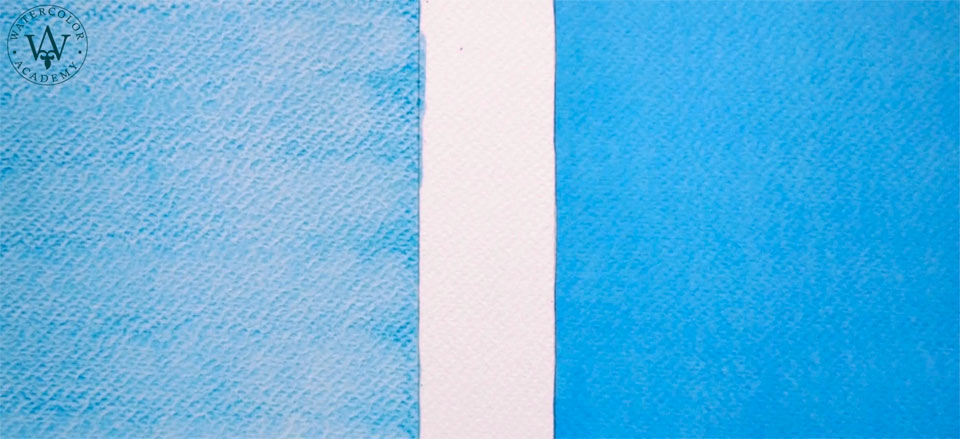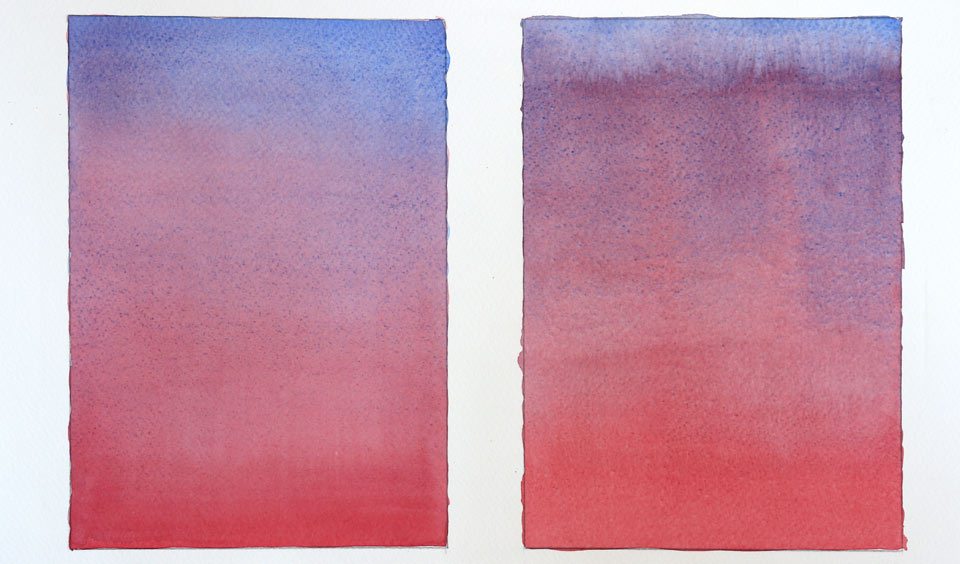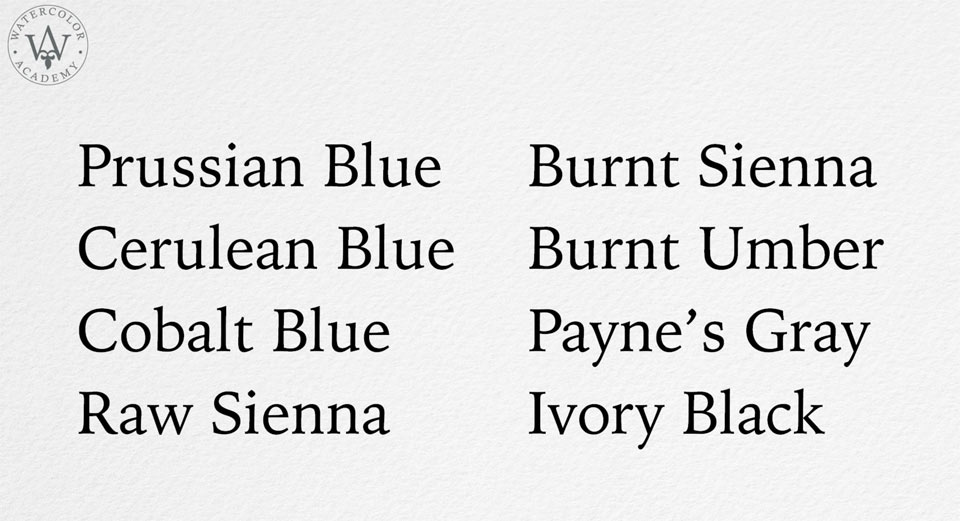A self-study, self-paced course where you can learn how to paint in watercolor by watching video lessons and doing assignments
$297 USD
ENROLL NOWA self-study, self-paced course where you can learn how to paint in watercolor by watching video lessons and doing assignments
$297 USD
ENROLL NOWOne-to-one, unlimited and custom-tailored to your skills and needs Personal Tutoring by the Watercolor Academy teachers
$997 USD
ENROLL NOWVideo lesson by Vladimir London
In this video lesson, you will discover what the granulated wash is and how to use it in watercolor painting.
For the purpose of this exercise, we will use two pigments: Cerulean blue and Phthalo blue.
First, I will make a plain wash with the Cerulean blue pigment. I am pre-mixing this paint in the saucer. You may notice that I am using a cheap synthetic brush because particles of this pigment are coarse and abrasive; therefore, for the purpose of mechanical mixing, I do not want to use a more expensive and high-quality type of brush.
The watercolor paper sheet is fixed to the board and this board is tilted at about 15 degrees. On this sheet, I will make two washes. On the left-hand side, there will be a granulated wash.
To begin with, I will paint with horizontal brush strokes. I load the first stripe with enough paint to form a bead. Every next brush stroke is overlapping the previous one, and the bead flows down from one stripe to another. An equal amount of paint is loaded onto the brush after each stroke.
Although I am following all of the rules of the plain wash method, you will notice that this wash is not really smooth, but stripy. There are visible borders between horizontal brush strokes. To improve the situation, I am now using the 'saw' wash method. This wash has such a name because diagonal brush strokes form a zig-zagging bead line at the bottom edge, which resembles the teeth of a saw. The saw wash gives a much smoother texture because the pigment flows down and the brush strokes are diagonal. Such an angle helps to intermix the paint on the paper more thoroughly.
Nevertheless, even with the saw wash, this blue rectangle has some faint brush marks. This happens because the Cerulean blue pigment is very heavy. It sinks to the bottom of the saucer very fast, and I have to stir this every time before loading the paint onto the brush. Heavy pigment particles are also sinking down onto the texture of the watercolor paper.
The watercolor paper sheet that I am using is "cold pressed", which means it has a medium-sized tooth, not too smooth and not too rough, but it is enough to cause the granulation of heavy pigment paint. Therefore, the granulated wash is not a special method of applying paint on paper, but is what happens to heavy pigments when they separate from water and sink down, collecting on the bottom of the paper tooth. The degree of granulation depends on several factors, but above all, on the weight and size of pigment particles.
I have now completed the wash with the heavy Cerulean blue pigment, and I will do another wash using the Phthalo blue paint. I will use the same painting method as for the previous wash.
By now, I think that you already know all the steps for the plain wash, and all the rules you have to follow in order for it to appear very smooth. Just to recap this information, I can remind you of the main rules of the plain wash. There should be enough pre-mixed pigment to last the entire wash. The watercolor paper sheet has to be fixed to the tilted board, and the tilt should be at about 15 degrees. At all times, you have to maintain the bead of paint by loading enough mix on the brush to make juicy brush strokes. The speed of brush strokes has to be constant – not too fast and not too slow – in order to allow the bead to flow down from one stripe to another. Every stroke has to overlap the neighboring brush strokes without missing any gaps. You cannot go back to repaint any areas while the paper surface is still wet. You have to move forward to complete the entire wash, then let it dry thoroughly, and when the wash is fully dry you can accurately fill in missing gaps, applying the same pigment with the small brush. After you start the wash, you can not take any breaks. It has to be done in one go with equal prompt intervals for reloading the brush. It is critical to maintain the juicy bead at all times. If there is not enough liquid in the bead, the paint will not flow from one brush stroke to another. If there is too much paint, it may break up its surface tension and run down in an uncontrollable stream.
I think that you can already see the difference between these two washes. They are made in the same way, both have a similar colour, but very different pigments are used. The wash on the left has a heavy and coarse pigment of Cerulean blue paint PB35. The pigment on the right is blue PB15. The heavy pigment on the left has separated and created a granulated wash. Its texture appears very different to the smooth wash on the right-hand side. This is especially apparent when I zoom in to see the heavy pigment particles settled in the depressions of the watercolor paper tooth.

Here, I will say a few words about why it is important to know about the granulated wash, how it may affect your watercolor artwork, and how to use the granulation effect in painting.
First of all, you need to know your pigments, which ones tend to granulate and which ones will give you a very smooth wash. For example, pigments such as Prussian blue, Cerulean blue, Cobalt blue, Raw Sienna, Burnt Sienna, Burnt Umber, Payne's Gray, Ivory Black and many other pigments will tend to granulate. Such process is also referred to as 'flocculation' and heavy pigment paints are also called 'sedimentary' watercolors. I will not cover the full list of granulating watercolor paints here, because the purpose of this lesson is different, so I will leave you to study the properties of watercolor paints you have, in order for you to build your knowledge of what you can expect from your paints.

As you have seen from the Cerulean blue example, it could be challenging to achieve a very smooth wash – either plain or gradated – when using sedimentary watercolor paints. So, if you would like to achive a very smooth color, it is better to avoid flocculating pigments. For example, for this girl's portrait, I used less sedimentary paints to make the skin colors and tones very smooth. However, if your creative goal is different, and you would like to have a very textured pattern, then you would have to use paints with larger and heavier pigment particles. For example, in this painting, the heavy earth pigments create an illusion of the horse's skin texture.
A self-study, self-paced course where you can learn how to paint in watercolor by watching video lessons and doing assignments
One-time payment - Lifetime membership
$297 USD
One-to-one, unlimited and custom-tailored to your skills and needs Personal Tutoring by the Watercolor Academy teachers
One-time payment - Lifetime membership
$997 USD